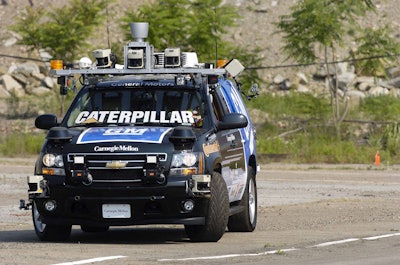
Autonomous vehicles are coming, it’s just a matter of when. That’s based on testimony and discussion this week during a hearing organized by the House transportation committee.
Panelists included National Highway Traffic Safety Administration Administrator David L. Strickland, whose agency is tasked with developing standards for technology that doesn’t yet exist, and representatives of General Motors and Nissan, who said the technology is closer to being ready for prime time than many people realize. In fact, Nissan’s Andrew Christensen noted, his company has set 2020 as the target date for a roadworthy vehicle, though GM’s Mike Robinson anticipates a more gradual introduction of semi-autonomous components, such as his company’s “super-cruise,” which would allow for periods of self-steering on highway stretches.
“It’s not a question of if, but when,” said Carnegie Mellon professor Raj Rajkumar, who emphasized the safety upside of autonomous vehicle technology. “This technology will basically prevent human beings from hurting themselves.”
But the real hurdles more social and economic than technical. The public will not only have to be convinced of the basic street skills of driverless cars, the technology will have to be secured against outside tampering. Additionally, manufacturers will need to know what the liability implications are going to be before making the investment needed for full-scale production.
Legislators were mixed in their opinions. Nevada Congresswoman Dina Titus noted that her state already had laws on the books regarding driverless test vehicles, while New Jersey Rep. Albio Sires wondered how such a vehicle could possibly negotiate the streets of New York City and called such a future “scary.” Rep. Roger Williams, a Texas car dealer by profession, suggested that any such vehicle would need to be able pull a horse trailer to sell in his state.
But, for a number of reasons, many analysts expect the first generation of driverless road transport to be commercial trucks instead of family sedans.
Here’s the bottom line, or the punch line, depending on whether you’re a fleet manager looking to cut costs, or a truck driver doing a job you like: “The use of autonomous long-haul trucks (ALHTs) could add up to a multibillion-dollar opportunity for companies throughout the trucking value chain.”
That’s from “The Next Autonomous Car Is a Truck,” a recent story from a management magazine called strategy + business. It’s just the latest contribution to the growing discussion of robo-rigs and auto-autos.
The s+b focus, of course, isn’t so much about the what or when, it’s about making a business decision — how much?
Author Peter Conway of Booz & Company estimates the cost of outfitting a truck as an 18-wheel robot could be as much as $200,000, tractor and trailer not included. That’s strictly a ballpark guess at this point, but just the radar system typically used in current-gen autonomous vehicles goes for $70,000 — though prices would certainly fall with wider adoption.
On the other side of the ledger, he suggests the savings could exceed $100,000 per truck annually.
Of course, “a significant portion of both the cost savings and the efficiency gains would come from eliminating drivers’ wages from the bottom line.”
As with the industrial robots and automated processes used so widely in manufacturing, not only do they replace humans and their wages, they keep going, and going and going.
The immediate upside for commercial fleets is the surge in truck productivity, without those pesky hours-of-service rules to worry about. But, as Conway notes, truck capacity would soar initially, since there’d still be all of those perfectly good human-operated trucks competing for loads.
Early adopters would profit nonetheless, he concludes.
“We won’t see highways dotted with driverless trucks in the near term. But the economics suggest that over the long term, the industry will migrate to autonomous vehicles,” Conway writes. “Trucking companies that deploy these technologies most effectively will secure industry-leading positions.”
Additionally, the OEMs and suppliers that provide the new equipment will quickly claim more market share.
“Given that heavy truck model changes occur infrequently, sometimes not for a decade or longer, ALHTs could be just one design cycle away,” he says.
Indeed, a fleet of self-driving, giant mining trucks is already deployed in a closed circuit at an Australian site. Most of the jobs done by drivers will be replaced by computers and remote operators by 2015, according to the report from The Australian.
“When we looked at our growth plans, we were not in a position where we thought we would find enough people to drive trucks,” Rio’s “mine of the future” boss, James Petty, says.
Stay tuned.








